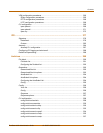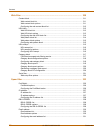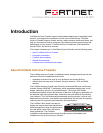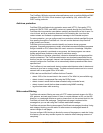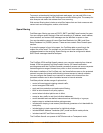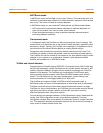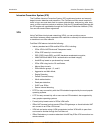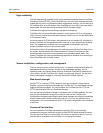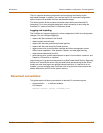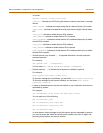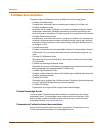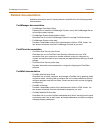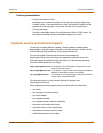
Introduction Intrusion Prevention System (IPS)
FortiGate-100A Administration Guide 01-28007-0068-20041203 17
Intrusion Prevention System (IPS)
The FortiGate Intrusion Prevention System (IPS) combines signature and anomaly
based intrusion detection and prevention. The FortiGate unit can record suspicious
traffic in logs, can send alert email to system administrators, and can log, pass, drop,
reset, or clear suspicious packets or sessions. Both the IPS predefined signatures and
the IPS engine are upgradeable through the FortiProtect Distribution Network (FDN).
You can also create custom signatures.
VPN
Using FortiGate virtual private networking (VPN), you can provide a secure
connection between widely separated office networks or securely link telecommuters
or travellers to an office network.
FortiGate VPN features include the following:
• Industry standard and ICSA-certified IPSec VPN, including:
• IPSec VPN in NAT/Route and Transparent mode,
• IPSec, ESP security in tunnel mode,
• DES, 3DES (triple-DES), and AES hardware accelerated encryption,
• HMAC MD5 and HMAC SHA1 authentication and data integrity,
• AutoIKE key based on pre-shared key tunnels,
• IPSec VPN using local or CA certificates,
• Manual Keys tunnels,
• Diffie-Hellman groups 1, 2, and 5,
• Aggressive and Main Mode,
• Replay Detection,
• Perfect Forward Secrecy,
• XAuth authentication,
• Dead peer detection,
• DHCP over IPSec,
• Secure Internet browsing.
• PPTP for easy connectivity with the VPN standard supported by the most popular
operating systems.
• L2TP for easy connectivity with a more secure VPN standard, also supported by
many popular operating systems.
• Firewall policy based control of IPSec VPN traffic.
• IPSec NAT traversal so that remote IPSec VPN gateways or clients behind a NAT
can connect to an IPSec VPN tunnel.
• VPN hub and spoke using a VPN concentrator to allow VPN traffic to pass from
one tunnel to another through the FortiGate unit.
• IPSec Redundancy to create a redundant AutoIKE key IPSec VPN connection to a
remote network.



